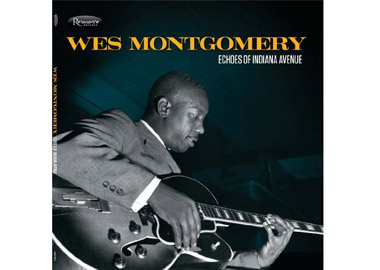Jazz guitarist Wes Montgomery became something of a phenomenon in the ’60s with his mellow and accessible version of jazz. Some of his albums even offered something most jazz players didn’t use: orchestras full of brass or strings. Pair that with Montgomery’s choice of material, which included pop songs, and it’s easy to see why a lot of people point to the guitarist’s mid-’60s albums as a launching point for the frequently maligned “smooth jazz” genre.
In a new release from Resonance Records, the unadorned sounds of Montgomery’s guitar are prominent and clear. No orchestra, overproduction or softening of harsh edges is evident.Thanks to its simplicity, Echoes of Indiana Avenue, the first album of newly discovered Montgomery music for decades (he died in 1968), reveals the early, unrefined work of a guitar innovator.
His most obvious innovation was a strange one. Give most non-guitarists a guitar, and they plant their right-hand fingers below the strings, using the thumb to pick and strum. Though it’s intuitive, the resulting hand position turns out to be extremely awkward. That’s why very, very few guitarists employ it.
Look at photos of Montgomery, however, and most of the time you’ll see his right hand splayed in just that fashion. The often-heard story about his adoption of that method is that his practicing—Montgomery only played electric—was too loud for his wife. Rather than turn down the amp, he used the side of his thumb like a pick. It successfully kept the peace, and somehow Montgomery made it work, even on fast solo passages.
The thumb-playing was a major factor in Montgomery’s trademark tone. It’s not quite like anyone else’s—where most jazz guitarists seem to gravitate toward a bassy, sometimes muffled tone with few sharp edges, Montgomery seems to have left the treble knob turned up. The availability of those higher sounds is offset by the softness of his thumb. The result is rounded and mellow yet full in its spectrum.
Montgomery, unusually enough for a jazz player, was totally self-taught, and part of the pleasure of checking out this new set of tunes is reading the extensive liner notes, in which his brothers tell tales of the young guitarist and his incredibly fast acquisition of sufficient musical knowledge to play jazz.
Once you’re armed with a fuller sense of just who Wes Montgomery was, listening to the tracks is a particular pleasure. The recordings turned up via eBay, and, whatever their provenance, offer sounds of Montgomery before his albums brought him greater prominence. With a lot of help and some good guesses, producer Zev Feldman reconstructed the info about who actually appears on the recordings, and their time and place. The tracks date to 1957 and ’58, and are an amalgam of studio recordings and live recordings from clubs around Indianopolis.
Montgomery shows off lots of his trademark moves, particularly playing melodies in octaves, and offers nicely constructed solos with a clear sense of narrative. This stripped-down version of Montgomery is the guitarist at his most elemental, and, whether or not you’re a fan of his later works, it’s a refreshing listen, a window into a singular player’s earliest days.



